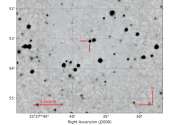Deep eclipses detected in the cataclysmic variable J0130
Russian astronomer Valery Kozhevnikov has conducted photometric observations of the cataclysmic variable (CV) IPHAS J013031.89+622132.3 (J0130 for short), finding that the object exhibits deep eclipses. The discovery, presented ...









